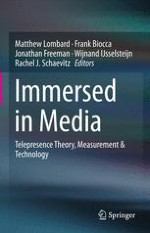2015 | OriginalPaper | Buchkapitel
8. Ways to Measure Spatial Presence: Review and Future Directions
verfasst von : Jari Laarni, Niklas Ravaja, Timo Saari, Saskia Böcking, Tilo Hartmann, Holger Schramm
Erschienen in: Immersed in Media
Aktivieren Sie unsere intelligente Suche, um passende Fachinhalte oder Patente zu finden.
Wählen Sie Textabschnitte aus um mit Künstlicher Intelligenz passenden Patente zu finden. powered by
Markieren Sie Textabschnitte, um KI-gestützt weitere passende Inhalte zu finden. powered by
